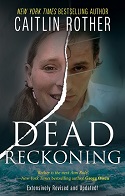 Synopsis:
Synopsis:
Gregg Olson’s “Notorious USA” series features a trilogy from from best-selling true crime novelist Caitlin Rother focused upon cases from Florida, George, and South Carolina, all available in one volume, Love Gone Wrong.
Florida may be “the Sunshine state” and a popular vacation destination, but it also houses more condemned killers awaiting execution than any state except California. In Kill Him Some More, Rother examines four cases — two sets of cases with similar factual underpinnings and vastly different outcomes. A former flight attendant alleged her multimillionaire boyfriend had abused her for years before she killed him — with a gun, knife, hammer, and maybe even poison. Another woman with a long history of failed relationships with drug abusers claimed she was forced by her boyfriend to put a gun into her mouth before she managed to use it on him. A mother who tried to prevent her 15-year-old daughter from ruining her life ended up stabbed, choked, and injected with a syringe full of bleach. And an equally well-meaning father was bludgeoned to death with a baseball bat as the result of a conspiracy between his 16-year-old daughter and her 20-year-old boyfriend.
In Dead on Delivery, three Georgia cases are detailed. A wealthy socialite was shot by a man delivering roses, not coincidentally on the very day a key ruling concerning the financial details of her divorce proceeding was set to be handed down. It took twenty years for justice to be served. In another case, a web of intertwined contract-for-hire murders were eventually uncovered after an unscrupulous businessman was gunned down in his driveway in the presence of his teenage son. Lastly, a mother of three convinced her boyfriend to kidnap, beat, and stab her husband so she could collect the proceeds of a $20,000 life insurance policy to pay off the small mortgage on the family home. Instead of living happily ever after in that house with her new lover, she ended up being only the second woman in history to be executed in Georgia. Not even the Pope could save her.
A Complicated Woman, the first volume released, focuses upon three South Carolina murderers.
Review:

In Love Gone Wrong, murders committed or commissioned by the victims’ significant others are spotlighted. Each story is fascinating, proving yet again that the old adage is accurate: Truth is indeed often stranger than fiction.
Kill Him Some More tackles the murder of Ronald Vinci, described by his attorney as “a man of integrity,” who built an empire from meager beginnings. He went to San Diego in the 1960’s with $1500 and some tools, but was a multimillionaire when in 2011, at age 71, his body was discovered in a Florida mansion. His girlfriend, former flight attendant Catherine Pileggi, spent eighteen years with Vinci in an on-again, off-again relationship that Vinci apparently had recently informed her was about to be off again. She admitted that she killed Vinci — after initially trying to convince a friend that Vinci had fallen down the stairs — but contended that she acted in self-defense. In a classic case of “overkill,” however, Pileggi didn’t just shoot Vince in the head. She also stabbed him in the chest five times, sliced his throat, and hit him in the head with a hammer. Next, Rother relates the story of Melissa and Bryan Sorendino, two drug addicted felons living on the opposite end of the socioeconomic spectrum. Like Pileggi, Sorendino claimed her husband, from whom she had been estranged since shortly after the wedding, forced the barrel of the gun into her mouth, so she “had to stop him before he killed me.” She killed him by lodging a bullet in his chest at close range — as well as another in the back of his head that exited via the right side of his skull, just for good measure.
The other two Florida cases are particularly tragic because they involve parents dying at the behest of their children. When Chuck and Vicki Robinson divorced for the second time in 1994, their eleven-year-old daughter, Valessa, missed her father, who moved to St. Louis and remarried. Living with her religious mother, Valessa acted out by experimenting with drugs and sex. She fell hard for Adam William Davis, four years her senior, who had a criminal record and no plans or prospects for a stable future. Undeterred, Valessa was determined to become pregnant with his child and marry him. Her mother found and read Valessa’s journal, an act which proved to be her undoing. Vicki planned to send Valessa to a residential Christian school for troubled girls, but the plan never came to fruition. Despite a courageous struggle, Vicki was killed by Davis, at her own daughter’s urging, who took up residence on death row in January 2000. Valessa was sentenced as an adult and served fifteen years before being released in 2013.
Only ninety-five miles from the Robinson home, Courtney Schulhoff’s father attempted to keep her away from Michael Morin. In 2004, Courtney told police that her father, Steve, had beaten her because she stole his credit cards and used them without authorization, planned to drop out of school, and refused to stop seeing Morin. Courtney and Morin provided differing accounts of how Steve came to be bludgeoned in his bedroom with a baseball bat, his body wrapped in bedclothes and, like Vicki Robinson’s, stuffed upside down into a plastic storage bin. Courtney and Morin wrote love letters while awaiting trial, quoting “Romeo and Juliet.” After being sentenced to life without the possibility of parole, Courtney changed her story, taking credit for the killing where she had previously insisted that Moran killed Steve even as she begged him not to. In an attempt to free Morin, she testified at Morin’s trial that she beat her father to beat out of anger at Steve having raped her. The ploy failed. Morin was convicted of murder and, although not condemned, like Courtney, will never be eligible for parole.
Sometimes justice takes a long time, as in the case of the Georgia murder of Lita Sullivan, who was gunned down just inside the 17,000-square-foot mansion in Florida where she had been residing after finally ending her nine year marriage to the faithless Jim Sullivan. Seeing a flower delivery man through a glass panel in the door, Lita opened it — and was no match for the gun-toting assassin. She died at age 35 in January 1987, but her husband did not stand trial until March 2006. He was convicted of murder, but not sentenced to die since some of the jurors were opposed, on the basis of religion, to the death penalty (Rother does not expound upon why those individuals qualified, in light of their beliefs, to serve as jurors.) Initially lacking enough solid evidence to charge Sullivan with murder, he was first indicted in 1992 under federal law of using interstate commerce facilities in the commission of murder for hire and three other charges, none of which stuck. However, luck and some attention from Hollywood, along with the dedication of seasoned investigators, finally resulted in a plea bargain for the hired killer in 1998. Sullivan, however, eluded capture until the case was featured on “America’s Most Wanted.” A tip permitted authorities to track Sullivan down, but they had to prevail in a lengthy extradition battle before Sullivan was returned to the United States and convicted of hiring an employee of a moving company to “take care of his wife” before the critical ruling in the Sullivans’ divorce proceeding. Sullivan was motivated to kill Lita because losing the divorce case was was going to “change [his] whole lifestyle.”
Rother also explores the convoluted tale of Richard Braun, who wanted to extricate himself from fraudulent business practices after giving up drugs and participating in AA meetings. A series of inept attempted murders, likened to a “comedy of errors,” appeared unrelated. But investigators got lucky when an employee of a murder-for-hire operation spanning Georgia, Florida, and Minnesota agreed to participate in a recorded telephone conversation with his boss. From there, details began to emerge and the puzzle pieces started falling into place, revealing “a crew of ragamuffin players” who, for the most part, never managed to carry out the murders for which they were contracted. The ringleader ended up serving a life sentence, while most of his crew brokered plea deals for themselves by revealing details. Soldier of Fortune magazine turned out to be a common denominator — the killers and would-be killers had been recruited through a “Gun for Hire” ad. The magazine paid judgments to the victims and ceased running those types of ads in 1986.
Lastly, Rother recounts the case of Kelly Renee Gissendaner, who found religion, demonstrated remorse, and completed a degree in theology while in prison where she counseled and assisted other inmates. Pleas for mercy from various religious groups, her own children, and even the Pope were futile. She was the second woman put to death in Georgia, the first execution of a woman having occurred seventy years earlier. Kelly married Douglas Gissendaner twice. After their first divorce, they both served in the U.S. Army. Eventually, they remarried. But they separated again after two years. Before they divorced a second time, Kelly fell in love with Gregory Bruce Owen, whom she convinced to murder Douglas so that she could collect the proceeds of a life insurance policy she believed existed. The policy limit was a mere $20,000 which Kelly planned to use to pay off the modest mortgage encumbering the Gissendaner residence. In the end, there was no life insurance policy. For Owen’s part, he was a willing participant in Kelly’s scheme because he figured that with Douglas out of the way, he would not have to fear that Kelly would again reconcile with her husband. And he would have a place to live.
In Love Gone Wrong, Rother employs the writing style that has made her a New York Times bestselling author. As usual, Rother’s thorough research of the cases she profiles is evident and her approach to each measured. Unlike Rother’s full-length books, each story is presented as a concise, quickly readable summary. Yet in true investigative style, Rother provides sufficient pertinent detail to provide her readers with an understanding of the major developments in each case, along with significant quotes from those involved, and an explanation of the ultimate resolution. She presents the legal bases for the defendants’ appeals and the results thereof using minimal “legalese” so that nonlawyers can appreciate the strategic machinations and their import. Most importantly, Rother makes no attempt to convince readers of the killers’ motives, instead including salient evidence that permits readers, like juries, to weight that evidence and draw their own conclusions. The cases of Vicki Robinson and Steve Schulhoff are the most emotionally wrenching give that they were victims of their own children and, in part, thanks to Rother characteristic restrained approach. With the death penalty the focus of intense scrutiny and debate, especially in California, Rother wisely concludes Love Gone Wrong with Gissendaner’s story, aptly titled Jailhouse Religion. Although each case is fascinating in its own right, it is Gissendaner’s that is the most thought-provoking and the one readers will likely find themselves pondering long after reading it. Once again, I find myself highly recommending Rother’s impeccable work. Love Gone Wrong is an enthralling and entertaining summer read.
















1 Comment
Pingback: Book Review: Then No One Can Have Her | Colloquium